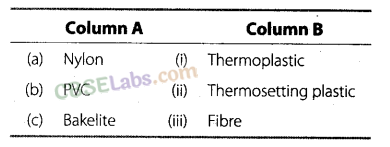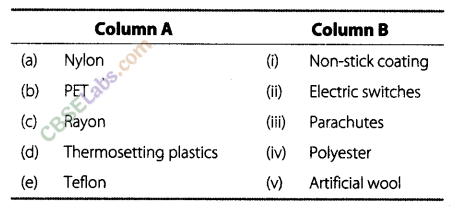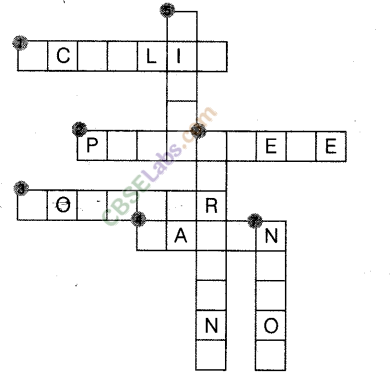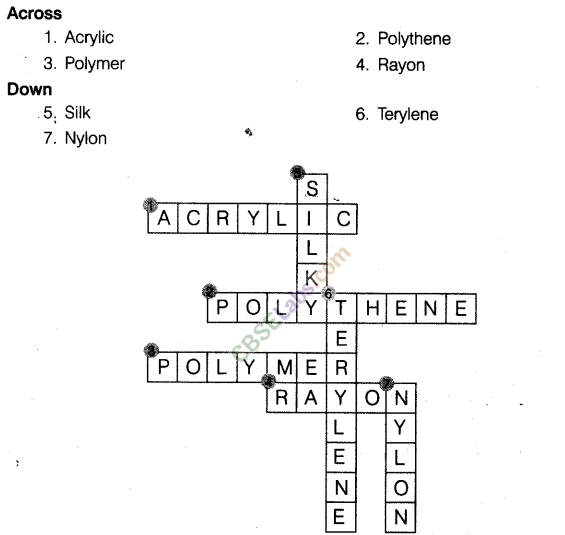NCERT Exemplar Class 8 Science Chapter 3 Synthetic Fibres and Plasticst are part of NCERT Exemplar Class 8 Science. Here we have given NCERT Exemplar Class 8 Science Chapter 3 Synthetic Fibres and Plastics.
NCERT Exemplar Class 8 Science Chapter 3 Synthetic Fibres and Plastics
Multiple Choice Questions
Question. 1 Pick the synthetic fibre out of the following.
(a) Cotton (b) Nylon (c)Jute (d)Wool
Answer. (b) Nylon Is a synthetic fibre. It is made without using any natural raw material. Cotton, jute and wool are natural fibres.
Question. 2 Which of the following is a source of rayon?
(a) Wool (b) PET (c) Wood pulp (d) Silk
Answer. (c) Wool pulp
Rayon is obtained by the chemical treatment of wool pulp (which contains cellulose).
Question. 3 Polycot is obtained by mixing
(a) nylon and wool (b) polyester and wool
(c) nylon and cotton (d) polyester and cotton
Answer. (d) Polycot is obtained by mixing polyester and cotton.
Polycot = polyester + cotton
Question. 4 Which is a thermosetting plastic?
(a) Melamine (b) Polythene –
(c) PVC (d) Nylon
Answer. (a) Melamine is a thermosetting plastic which when moulded once, cannot be softened by heating.
Question. 5 The material similar to silk in appearance is
(a) nylon (b) rayon
(c) polyester (d) terylene
Answer. (b) Rayon resembles silk in appearance, therefore, rayon is also called artificial silk.
Question. 6 The most suitable material for the preparation of handles of cooking utensils is (a) polythene (b) PVC
(c) nylon (d) bakelite
Answer. (d) Bakelite is used for making the handles of various cooking utensils because it is a poor conductor of heat and does not become soft on getting heated.
Question. 7 Which of the following is not a common property of plastics?
(a) Non-reactive
(b) Light in weight
(c) Durable
(d) Good conductor of electricity
Answer. (d) Plastics are non-reactive, light in weight and durable but they do not conduct electricity.
Question. 8 Which of the following represents the correct match for items in Column A with those in Column B.

Codes
(a) (a)-(ii), (b)-(iii), (c)-(i)
(b) (a)-(iii), (b)-(i), (c)-(ii)
(c) (a)-(ii), (b)-(i), (c)-(iii)
(d) (a)-(iii), (b)-(ii), (c)-(i)
Answer. (c) Nylon —-> Fibre , PVC —->Thermoplastic , Bakelite —->Thermosetting plastic
Question. 9 Which of the following groups contains all synthetic substances?
(a) Nylon, tprylene, wool
(b) Cotton, polycot, rayon
(c) PVC, polythene, bakelite
(d) Acrylic, silk, wool
Answer. (c) PVC, polythene and bakelite are synthetic substances.
Question. 10 The material which is commonly used for making kitchen containers is
(a) PVC (b) acrylic
(c) teflon (d) PET
Answer. (d) PET is ‘poly-ethylene’ terephthalate’ PET as a plastic is very light weight and is commonly used for making kitchen containers.
Very Short Answer Type Questions
Question. 11 Cotton is a natural polymer. What is its chemical name?
Answer. Chemical name of natural polymer of cotton is cellulose.
Question. 12 A synthetic fibre which looks like silk is obtained by chemical treatment of wood pulp. It is, therefore, known as artificial silk. What is its common name?
Answer. Its common name is rayon. Rayon is often regarded as artificial silk.
Question. 13 Terrycot is made by mixing two types of fibres. Write the names of the fibres.
Answer. Terrycot is made by mixing terylene and cotton.
Question. 14 Plastic articles are available in all possible shapes and sizes. Can you tell why?
Answer. Plastics can be easily moulded, so they are used to make a large variety of articles (or objects) having different shapes and sizes.
Question. 15 Plastic is used for making a large variety of articles of daily use and these articles are very attractive. But it is advised to avoid the use of plastic as far as possible. Why?
Answer. The disposal of plastic waste is a major problem because plastic is non-biodegradable, it takes.several years to decompose. Thus, cause environmental pollution. So, we should avoid use of plastics, as for as possible.
Question. 16 Why is it not advisable to burn plastic and synthetic fabrics?
Answer. Burning of plastics and synthetic fabrics produces lots of poisonous gases causing air pollution. So, it is not advisable to burn plastic and synthetic fibres.
Question. 17 Select the articles from the following list which are biodegradable.
(a) Paper
(b) Woollen clothes
(c) Wood
(d) Aluminium can
(e) Plastic bag
(f) Peels of vegetables
Answer. The biodegradable articles are:
(a) paper (b) woollen clothes
(c) wood (f) peels of vegetables
Question. 18 A bucket made of plastic does not rust like a bucket made up of iron. Why?
Answer. Plastic is non-reactive material. When left exposed to moisture and air, it does not react with air and water which are essential for corrosion, therefore does not rust.
Short Answer Type Questions
Question. 19 Rohit took with him some nylon ropes, when he was going for rock climbing. Can you tell why he selected nylon ropes instead of ropes made up of cotton or jute?
Answer. Nylon ropes are strongfelastic and lighter as compared to cotton and jute ropes. A nylon thread is actually stronger than a steel wire of similar thickness.
Question. 20 A lady went to the market to buy a blanket. The shopkeeper showed her blankets made up of acrylic fibres as well as made up of wool. She preferred to buy an acrylic blanket. Can you guess why?
Answer. Acrylic blankets are cheap, light in weight, more durable and are available in variety of colours and designs. They can be easily washed at home.
Question. 21 PVC (polyvinyl chloride) is a thermoplastic and is used for making toys, chappals, etc. Bakelite is a thermosetting plastic and is used for making electrical switches, handles of various utensils, etc. Can you write the major difference between these two types of plastics?
Answer. Thermoplastics get deformed easily on heating and can be bent easily on heating. On the other hand, thermosetting plastics when moulded once cannot be softened on heating.
Thermoplastics —–>Polythene and PVC ‘
Thermosetting plastics —–> Bakelite and melamine
Question. 22 Fill in the blanks.
- A polymer is a chain of many small units joined together which are
called……………………. - The synthetic fibres are also known as…………………….fibres.
- The first fully synthetic fibre was…………………… .
- A fibre similar to wool is…………………….
- A plastic used for making crockery is…………………….
Answer.
- monomers
- man-made
- nylon
- acrylic
- melamine
Question. 23 Match items in Column A with the terms of Column B.

Answer. The correct matching is as given:
(a)—(iii), (b)—(iv), (c)—(v), (d)—(ii), (e)-(i)
Question. 24 Unscramble the jumbled materials. words given below, related to synthetic
(a) Anory (b) Lopmery
(c) Relyteen (d) Laspict
(e) Yespolter (f) Felton
Answer. (a) Rayon (b) Polymer
(c) Terylene (d) Plastic
(e) Polyester (f) Teflon
Long Answer Type Questions
Question. 25 State whether the following statements are True/False.
- The fabric tery wool is obtained by mixing terylene and wool.
- Synthetic fibre do not melt on heating.
- It is risky to wear synthetic clothes while working in the kitchen.
- Most of the plastics are biodegradable.
Answer.
- True
- False, synthetic fibres melt on heating.
- True, a disadvantage as synthetic fibre is that they melt on heating.
- False, most of the plastics are non-biodegradable.
Question. 26 Write the importance of synthetic polymers in our life.
Answer. The importance of synthetic polymers in our life are as follows:
- Nylon It is used for making ropes for rock climbing, fishing nets, raincoats, parachutes and tyre cords, etc.
- Acrylic It is used for sweaters, track suits, linings for boots and gloves and In furnishing fabrics and carpets.
- Terylene It is used in textile industry to make clothes like sarees, tapestry and dress material. It is also mixed with natural fibre like cotton and wool to make more variety of clothes.
- Plastics It is used to store food item, water, milk, pickles, dry food, etc. Plastic containers seem most convenient.
This is because of light weight, low price, good strength and easy handling as compared to metals. Plastics are used in cars, air crafts and spacecrafts.
Question. 27 Despite being very useful, it is advised to restrict the use of plastic. Why is it so? Can you suggest some methods to limit its consumption?
Answer. It is advised to restrict the use of plastic because of the following reasons:
- The articles mades of plastics are non-biodegradable. They do not decompose (or rot) easily. This causes a great problem in the disposal of plastic wastes.
- The burning of plastic wastes gives out harmful gases which pollute the air. So, it is not advisable to dispose of the used plastic articles by burning.
Question. 28 Write an activity to show that synthetic fibres are stronger than the cotton fibres.
Answer. Activity Take threads of cotton and nylon (synthetic fibres) of about same length and thickness.. Hang cotton, thread from a stand. Attach a pan at the other end of the thread.
Add weights, one by one, to the pan until the thread breaks (see fig.) note the total weight required to break the cotton thread. This gives a measure of the tensile strength of the thread. Repeat the same with nylon thread.

Conclusion
Much more weight is required to break the nylon thread showing that nylon thread has a grater strength that the cotton thread.
Question. 29 Crossword Puzzle Complete the crossword given below with the help of clues.
Across
1. Substance used as synthetic wool. (7)
2. A plastic used for making containers and carry bags. (9)
3. Substance made up of large number of smaller molecules. (7)
4. Another name for this compound is artificial silk. (5)
Down
5. A type of fibre obtained naturally from cocoon. (4)
6. A synthetic fibre classified as polyester. (8)
7. A polymer used for making ropes. (5)

Answer.

NCERT Exemplar Class 8 Science Solutions
- Chapter 1 Crop Production and Management
- Chapter 2 Microorganisms: Friend and Foe
- Chapter 3 Synthetic Fibres and Plastics
- Chapter 4 Materials : Metals and Non-Metals
- Chapter 5 Coal and Petroleum
- Chapter 6 Combustion and Flame
- Chapter 7 Conservation of Plants and Animals
- Chapter 8 Cell Structure and Functions
- Chapter 9 Reproduction in Animals
- Chapter 10 Reaching the Age of Adolescence
- Chapter 11 Force and Pressure
- Chapter 12 Friction
- Chapter 13 Sound
- Chapter 14 Chemical Effects of Electric Current
- Chapter 15 Some Natural Phenomena
- Chapter 16 Light
- Chapter 17 Stars and the Solar System
- Chapter 18 Pollution of Air and Water
NCERT Exemplar SolutionsNCERT Exemplar MathsNCERT Exemplar Science
We hope the NCERT Exemplar Class 8 Science Chapter 3 Synthetic Fibres and Plastics help you. If you have any query regarding NCERT Exemplar Class 8 Science Chapter 3 Synthetic Fibres and Plastics, drop a comment below and we will get back to you at the earliest.